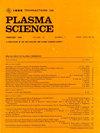局部热不平衡和磁场对从下加热的旋转部分电离等离子体稳定性的影响
IF 1.3
4区 物理与天体物理
Q3 PHYSICS, FLUIDS & PLASMAS
引用次数: 0
摘要
本研究考察了局部热不平衡(LTNE)对多孔介质中旋转部分电离等离子体(PIP)稳定性的影响。在不同的边界条件(bc)下,对从下面加热的等离子体进行了分析。进行了非线性(通过能量法)和线性(使用正态分析)分析。两种框架下的特征值问题均采用Galerkin方法表述和求解,选择满足bc的三角基函数或多项式基函数,保证了数值结果的鲁棒性和可靠性。这些发现强调了介质渗透率、可压缩性、旋转和磁场对系统稳定性特性的重要作用。同时考虑了等离子体组分间碰撞频率和热扩散率对能量衰减的影响。研究结果表明,在非线性和线性分析中,瑞利-达西数是相同的,从而否定了亚临界区域的存在,并肯定了全球稳定性。旋转、磁场影响、可压缩性和相间传热的稳定效应与优化聚变反应堆中的等离子体约束和理解天体物理现象(如吸积盘)的稳定性直接相关。相反,增加的渗透率和更高的孔隙率修正电导率比显示出不稳定趋势,加速对流的发生。刚性-刚性边界面被认为在限制PIP方面更稳定。这些发现强调了在先进热管理系统、等离子体约束技术和其他需要精确控制稳定性和传热的工程设计中的潜在应用。本文章由计算机程序翻译,如有差异,请以英文原文为准。
Effects of Local Thermal Nonequilibrium and Magnetic Fields on the Stability of Rotating Partially Ionized Plasma Heated From Below
This study examines the impact of local thermal nonequilibrium (LTNE) on the stability of rotating partially ionized plasma (PIP) within a porous medium. The plasma, subjected to heating from below, is analyzed under various boundary conditions (BCs). Both nonlinear (via the energy method) and linear (using normal mode analysis) analyses are performed. Eigenvalue problems in both frameworks are formulated and solved using the Galerkin method, employing trigonometric or polynomial basis functions chosen to satisfy BCs, ensuring the robustness and reliability of the numerical results. The findings underscore the significant roles of medium permeability, compressibility, rotation, and magnetic fields on the stability characteristics of the system. The influence of collisional frequency among plasma components and the thermal diffusivity ratio on energy decay is also considered. The findings demonstrate that the Rayleigh-Darcy number is the same across both nonlinear and linear analyses, thereby negating the presence of a subcritical region and affirming global stability. Stabilizing effects of rotation, magnetic field influence, compressibility, and interphase heat transfer have direct relevance for optimizing plasma confinement in fusion reactors and understanding stability in astrophysical phenomena, such as accretion disks. Conversely, increased permeability and a higher porosity-modified conductivity ratio demonstrate destabilizing tendencies, hastening the onset of convection. Rigid-rigid bounding surfaces are identified as thermally more stable for confining the PIP. These findings underscore potential applications in advanced thermal management systems, plasma confinement technology, and other engineering designs requiring precise control over stability and heat transfer.
求助全文
通过发布文献求助,成功后即可免费获取论文全文。
去求助
来源期刊

IEEE Transactions on Plasma Science
物理-物理:流体与等离子体
CiteScore
3.00
自引率
20.00%
发文量
538
审稿时长
3.8 months
期刊介绍:
The scope covers all aspects of the theory and application of plasma science. It includes the following areas: magnetohydrodynamics; thermionics and plasma diodes; basic plasma phenomena; gaseous electronics; microwave/plasma interaction; electron, ion, and plasma sources; space plasmas; intense electron and ion beams; laser-plasma interactions; plasma diagnostics; plasma chemistry and processing; solid-state plasmas; plasma heating; plasma for controlled fusion research; high energy density plasmas; industrial/commercial applications of plasma physics; plasma waves and instabilities; and high power microwave and submillimeter wave generation.
 求助内容:
求助内容: 应助结果提醒方式:
应助结果提醒方式:


